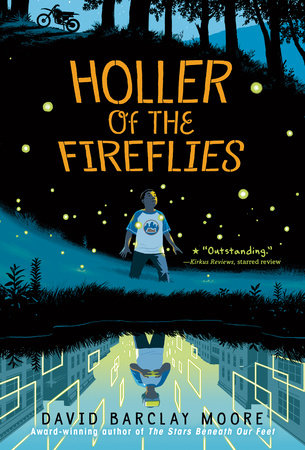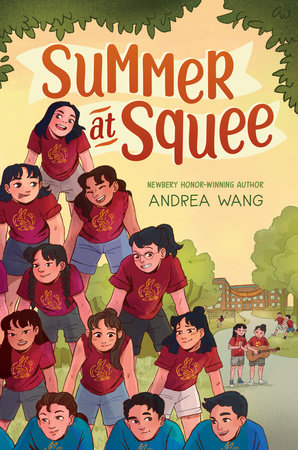Who could forget their summer camp experience?
For many children, sleep-away camps or day-camps can be both exciting and anxiety-producing. I remember going to a sleep-away camp when I was in middle school. It lasted a week. It felt like two months. Also, someone very close to me once received a disconcerting drawing from an eleven-year-old at a week-long camp:

It should be noted, the child ultimately decided it was “good to get out of my comfort zone.”
How can you help your child or student anticipate or reflect on camp experiences?
2. Writing stories about camp (whether it be real or imagined)
3. Talking about their feelings
4. Reading books about camps! Whether or not a child plans to attend a summer camp, middle grade books about young protagonists triumphing in challenging, scary or even hilariously over-the-top camp situations can be both inspiring and entertaining.
Listed below are ten wonderful middle grade books that feature summer camps:
Be Prepared by Vera Brosgol
 In Be Prepared, all Vera wants to do is fit in—but that’s not easy for a Russian girl in the suburbs. Her friends live in fancy houses and their parents can afford to send them to the best summer camps. Vera’s single mother can’t afford that sort of luxury, but there’s one summer camp in her price range—Russian summer camp.
In Be Prepared, all Vera wants to do is fit in—but that’s not easy for a Russian girl in the suburbs. Her friends live in fancy houses and their parents can afford to send them to the best summer camps. Vera’s single mother can’t afford that sort of luxury, but there’s one summer camp in her price range—Russian summer camp.
Vera is sure she’s found the one place she can fit in, but camp is far from what she imagined. And nothing could prepare her for all the “cool girl” drama, endless Russian history lessons, and outhouses straight out of nightmares!
Here in the Real World by Sara Pennypacker

Ware can’t wait to spend summer “off in his own world”—dreaming of knights in the Middle Ages and generally being left alone. But then his parents sign him up for dreaded Rec camp, where he must endure Meaningful Social Interaction and whatever activities so-called “normal” kids do.
On his first day Ware meets Jolene, a tough, secretive girl planting a garden in the rubble of an abandoned church next to the camp. Soon he starts skipping Rec, creating a castle-like space of his own in the church lot.
Jolene scoffs, calling him a dreamer—he doesn’t live in the “real world” like she does. As different as Ware and Jolene are, though, they have one thing in common: for them, the lot is a refuge.
But when their sanctuary is threatened, Ware looks to the knights’ Code of Chivalry: Thou shalt do battle against unfairness wherever faced with it. Thou shalt be always the champion of the Right and Good—and vows to save the lot.
But what does a hero look like in real life? And what can two misfit kids do?
Holler of the Fireflies by David Barclay Moore

Javari knew that West Virginia would be different from his home in Bushwick, Brooklyn. But his first day at STEM Camp in a little Appalachian town is still a shock. Though run-ins with the police are just the same here. Not good.
Javari will learn a lot about science, tech, engineering, and math at camp. And also about rich people, racism, and hidden agendas. But it’s Cricket, a local boy, budding activist, and occasional thief, who will show him a different side of the holler—and blow his mind wide open.
Javari is about to have that summer. Where everything gets messy and complicated and confusing . . . and you wouldn’t want it any other way.
J + C + summer = ∞
Lions and Liars by Kate Beasley

Frederick Frederickson has a food-chain theory about life. There are lions, like the school bully. Gazelles, like the bullied kids. There are meerkats, and the fleas that live on the butts of meerkats. Frederick’s a flea.
Fifth grade is off to a terrible start when Frederick is sent to a disciplinary camp for troublesome boys. His fellow troop mates—Nosebleed, Specs, The Professor, and little-yet-lethal Ant Bite—are terrifying. But in between trust-building exercises and midnight escape attempts, a tenuous friendship grows between them. Which is lucky, because a Category 5 hurricane is coming and everyone will have to work together—lions and fleas alike—to survive!
Mirror to Mirror by Rajani LaRocca

Maya is the pragmatic twin, but her secret anxiety threatens to overwhelm her.
Chaya is the outgoing twin. When she sees her beloved sister suffering, she wants to tell their parents—which makes Maya feel completely betrayed. With Maya shutting her out, Chaya makes a dramatic change to give her twin the space she seems to need. But that’s the last thing Maya wants, and the girls just drift further apart.
The once-close sisters can’t seem to find their rhythm, so they make a bet: they’ll switch places at their summer camp, and whoever can keep the ruse going longer will get to decide where they both attend high school—the source of frequent arguments. But stepping into each other’s shoes comes with its own difficulties, and the girls don’t know how they’re going to make it.
Stella Díaz Never Gives Up by Angela Dominguez

Stella gets a big surprise when her mom plans a trip to visit their family in Mexico! Stella loves marine animals, and she can’t wait to see the ocean for the first time . . . until she arrives and learns that the sea and its life forms are in danger due to pollution.
Stella wants to save the ocean, but she knows she can’t do it alone. It’s going to take a lot of work and help from old and new friends to make a difference, but Stella Díaz never gives up!
Summer at Squee by Andrea Wang

Phoenny Fang plans to have the best summer ever. She’s returning to Summertime Chinese Culture, Wellness, and Enrichment Experience (SCCWEE for short and “Squee” to campers in the know), and this year she’s a senior camper. That means she; her best friend, Lyrica Chu; and her whole Squad will have the most influence. It almost doesn’t matter that her brother is a CIT (counselor-in-training) and that her mom and auntie are the camp directors. Time spent at Squee is sacred, glorious, and free.
On the day Phoenny arrives, though, she learns that the Squad has been split up, and there’s an influx of new campers this year. Phoenny is determined to be welcoming and to share all the things she loves about camp—who doesn’t love spending hours talking about and engaging in cultural activities? But she quickly learns how out of touch she is with others’ experiences, particularly of the campers who are adoptees. The same things that make her feel connected to her culture and community make some of the other campers feel excluded.
Summer at Squee turns out to be even more transformative than Phoenny could’ve imagined, with new friendships, her first crush, an epic show, and a bigger love for and understanding of her community.
Summer Vamp by Violet Chan Karim

After a lackluster school year, Maya anticipates an even more disappointing summer. The only thing she’s looking forward to is cooking and mixing ingredients in the kitchen, which these days brings her more joy than mingling with her peers . . . that is until her dad’s girlfriend registers her for culinary summer camp! Maya’s summer is saved! . . . or not.
What was meant to be a summer filled with baking pastries and cooking pasta is suddenly looking a lot . . . paler?! Why do all of the kids have pointy fangs? And hate garlic? Turns out that Maya isn’t at culinary camp—she’s at a camp for VAMPIRES! Maya has a lot to learn if she’s going to survive this summer . . . and if she’s lucky, she might even make some friends along the way.
Teen Canteen: Rocky Road by Amalie Jahn
On the final night of summer camp, Tasha, Raelynn, Claire, and Billie get busted stuffing themselves with ice cream in the mess hall’s walk-in freezer. But when they slip away without being punished, they’re convinced the pink feather boa Billie put on to stay warm is magic.
Back at home, each member of Team Canteen tests the boa’s powers as they face their own challenges. When her little cousin moves in with her destructive dog, Tasha struggles to find her place inside her adoptive family. Claire’s scared the kids at school will find out how hard life’s gotten since her dad lost his job. Raelynn longs to be someone other than her sister’s twin. And with a hockey-obsessed family charting his every move, Billie’s worried he’ll never be able share his dream of becoming a figure skater.
It’s going to be a rocky road from the start of the school year back to Camp Happy Hollow. Will the boa continue to protect Team Canteen, or will their friendship end up being the most magical find of all?
Alternating among the friends, Rocky Road is a smart, soaring celebration of the highs and lows of middle school, and the unbreakable friendships that see you through, no matter what comes next.
Twelfth by Janet Key

Twelve-year-old Maren is sure theater camp isn’t for her. Theater camp is for loud, confident, artsy people: people like her older sister, Hadley–the last person Maren wants to think about–and her cinema-obsessed, nonbinary bunkmate, Theo. But when a prank goes wrong, Maren gets drawn into the hunt for a diamond ring that, legend has it, is linked to the camp’s namesake, Charlotte “Charlie” Goodman, a promising director in Blacklist Era Hollywood.
When Maren connects the clues to Shakespeare’s Twelfth Night, she and her new friends are off searching through lighting booths, orchestra pits and costume storages, discovering the trail and dodging camp counselors. But they’re not the only ones searching for the ring, and with the growing threat of camp closing forever, they’re almost out of time.
Let me know below other great middle grade reads that feature summer camp!
















 Janet Slingerland has written over 2 dozen books for young readers. To find out more about Janet and her books, check out her website:
Janet Slingerland has written over 2 dozen books for young readers. To find out more about Janet and her books, check out her website: